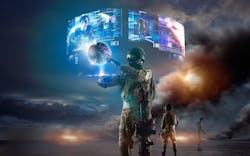Army asks industry for virtual reality technologies for next-gen infantry simulation and mission rehearsal
ABERDEEN PROVING GROUND, Md. – U.S. Army researchers are asking industry to develop enabling technologies in virtual reality for infantry simulation and mission rehearsal.
Officials of the Army Contracting Command at Aberdeen Proving Ground, Md., has issued a request for information for the Technologies for Mission Rehearsal and Training project.
This project seeks new enabling technologies in augmented reality, mixed reality, and virtual reality for future Army simulation and mission rehearsal systems to help Army infantry warfighters fight more effectively.
Traditional mission rehearsal requires a physical range that is set up to mimic different mission areas, amenable weather and lighting, and relevant terrain and temperatures. Some construction can be necessary to simulate targets like roads and buildings, and clandestine laboratories.
Related: Simulation and mission rehearsal relies on state-of-the-art computing
Virtual Reality (VR) is a computer-generated environment with scenes and objects that appear to be real to make users feel that they are immersed in their surroundings. Imagery and sounds go to the user through a virtual reality headset or helmet.
Augmented reality uses computer enhancement of the physical world, such as sound, still, images, video, and graphic overlays. Mixed reality blends physical and digital worlds, and enables users to interact with real and computer-generated objects and people.
Simulation and mission rehearsal range safety, availability, and location can present challenges such as cost to transport troops, provision ranges, and collection of data. New mission rehearsal and training options may mitigate some of these challenges. Taken together, virtual, augmented, and mixed reality are called extended reality.
Related: Deployable simulation and training
From industry, Army researchers want information on extended reality technologies that can help simulate or represent training and mission rehearsal elements such as environments; image and data fusion; deployment options; warfighters operating on foot or in vehicles; reconnaissance; chemical and biological detectors; uncrewed vehicles; after-action reports; and multiple perspectives.
Companies interested should let the Army know if they have can support these kinds of technologies, and if these technologies could support a common extended-reality environment accessible to users at different locations.
Army researchers also want to know about communications in unclassified extended-reality environments; the ability to simulate real-world and custom-designed locations; the ability to create objects like cars, military vehicles, desks, chairs,and storage containers.
Researchers also are interested in other kinds of extended-reality enabling technologies for simulation and mission rehearsal, and what are some of the greatest challenges that systems designers face. Also of interest are industry standards for extended reality in simulation and mission rehearsal.
Companies interested should email capabilities statements, videos, and Power Point presentations no later than 2 May 2022 to the Army's Jessica Green-Farley at [email protected], or Brian Mazen at [email protected].
Email questions or concerns to Jessica Green-Farley at [email protected], or Brian Mazen at [email protected]. More information is online at https://sam.gov/opp/a66a50b119464dd087f550ded54d3d8b/view.
About the Author
John Keller
Editor-in-Chief
John Keller is the Editor-in-Chief, Military & Aerospace Electronics Magazine--provides extensive coverage and analysis of enabling electronics and optoelectronic technologies in military, space and commercial aviation applications. John has been a member of the Military & Aerospace Electronics staff since 1989 and chief editor since 1995.
